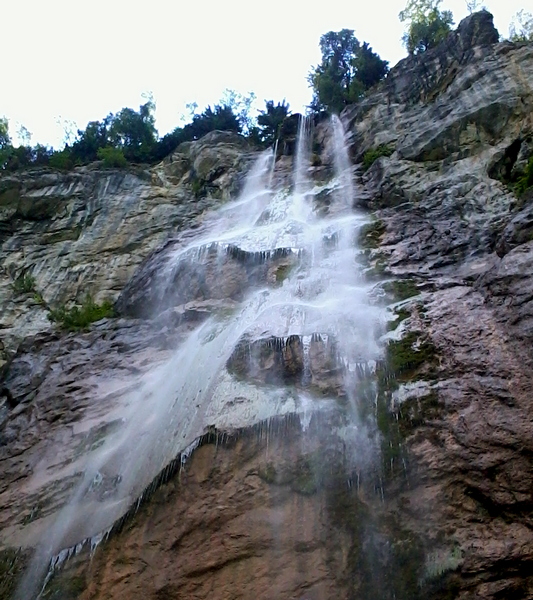Hitching to Sarajevo
In Ljubljana I met Matt. He studied in Krakow for a semester and picked up on the Polish national sport – hitchhiking. Since May he had been traveling exclusively by hitchhiking and couchsurfing, relying on chance and the kindness of strangers. We hung out in Metelkovo and explored Ljubljana together and made plans to hitchhike to Zagreb.
You can’t just get a ride from anywhere. There are certain spots and a website that lists them. We took city bikes to the edge of the network, walked about a kilometer to an overpass, climbed down a hidden path and went through an opening in the fence to get to the highway. From there it was a short walk to the gas station where we would try our luck. Our luck turned out to be terrible. We couldn’t find a ride the whole day and it was small consolation that two other pairs of hitchhikers got stuck with us. However we also met two German “boy-scouts”, as Matt called them. They had neat haircuts and cargo shorts; both seemed to be well into their 30’s. They were experienced hitchers and traveled a lot of the world, even hitching from India to Europe (though they took a bus through Afghanistan). Somehow within an hour of meeting them they disappeared. By midnight we gave up.
Together with the other hitchhikers we made a little encampment in a little tree island near the exit. We woke up at sunrise with a new determination to do better. Maybe it was just luck or because rather than Zagreb we named a town on the Slovenian border, but very soon a truck driver gave us a lift to somewhere halfway to the border. We had a breakfast of gas station snacks. Soon a woman going to visit her sister took us all the way to Zagreb. So within a couple hours we made it all the way to our target and we could just ignore the ten hours wasted yesterday.
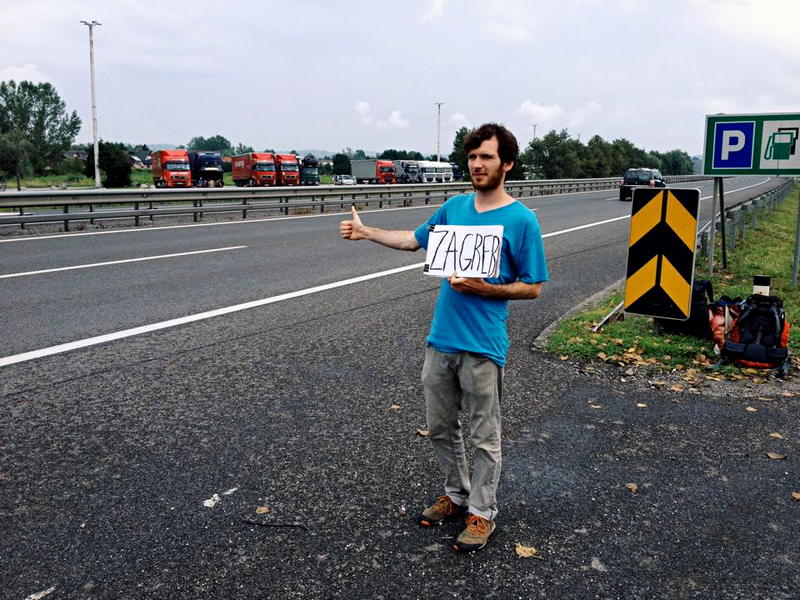
This wasn’t usual. Matt told me he never had to wait long for a ride. Maybe it was that there were two of us. I did not think this is the kind of question that could be answered, just something to be accepted. Everything is so out of your control that it’s about the only thing you can do. It’s also very easy to become superstitious. For example Matt thought that eating an apple would immediately produce a ride. I was struck by how giving a ride is a pure gift. We would never see the person again and we couldn’t even provide conversation since we spoke a different language. Even before I got my first ride I decided I would have to give rides after returning home.
In addition to hitchhiking I decided to try couchsurfing again as well. Matt’s stories restored my faith in it. But it was even less successful that hitchhiking. By the time we got to Sarajevo I decided to wait until September to give it another try. It seemed that everyone was either visiting family, traveling or already hosting someone in this busy traveling season.
One of the pleasures of spending some time with a person is that it provides an audience for harmless lies. I got tired of answering the same questions from people we met and it’s a lot more fun to embellish when someone is in on it.
We tried to arrange couchsurfing in Zagreb but it only half worked. We met a local, Oto, and he told us his landlord was renting a room. It was cheaper than a hostel and we’d have a local friend. Before retiring for the night we drank in a park with Oto and an Italian couchsurfing couple. In Yugoslavia it’s common to find two liter bottles of beer for the same price as we sell cola.
In the morning we woke up to our landlord drinking beer on the patio. He treated us to excellent scrambled eggs and beer and tried to convince us that morality is impossible without god.
Zagreb is much more spread out than Ljubljana and the old town doesn’t have the same magnetic draw. The city does not reveal its charms easily. We took a bus to the mountains just outside the city and followed a trail through the forest to Medvedgrad. It’s yet another fortress overlooking a city. Very little remains of the original but a basic square tower was constructed recently as it appears and from there a great view opens up. We slid down the wet ground to the bus stop and didn’t pay for a ticket. Plums were in season and we picked a few from a yard we passed.
In Zagreb we got used to a diet of burek and related baked goods. Burek only properly refers to a meat pastry made with philo dough and it is common throughout Yugoslavia. One can also find variants with cheese, spinach and squash.
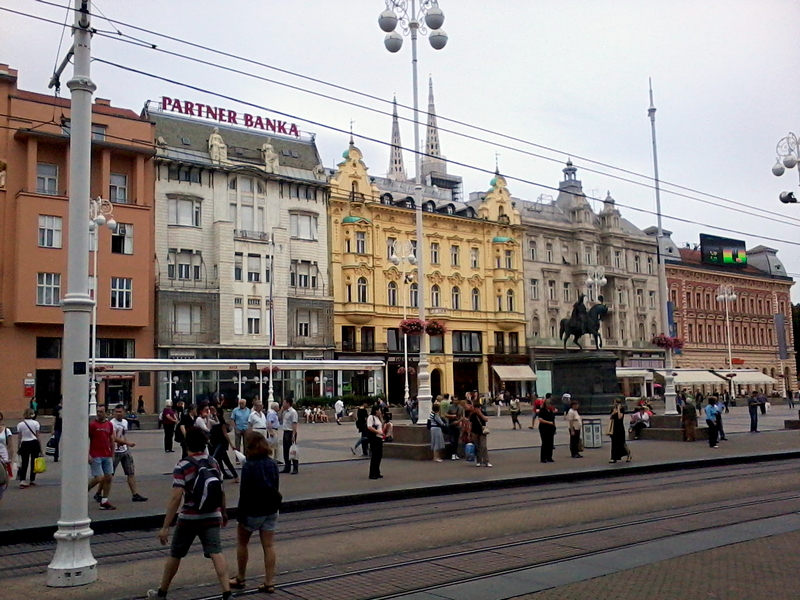
We left Zagreb quite late the next day. By the time we woke up, ate, said goodbyes to the owner and took the long bus ride to the hitching spot it was nearing five o’clock. We were a bit luckier than the previous day and got a few short rides that placed us right across the border with Bosnia. It was dark and traffic was sparse. I saw Cyrilic on road signs for the first time. We reinforced ourselves with some snacks and beers from a gas station and listened to ambient music from our phones. A couple more short rides, including one from a drunk driver, and we were in Banja Luka – capital of Republica Srpska. It was three in the morning. After a long walk we got to the main square and using the free wi-fi provided by the city found a hostel not too far away. Drunk revelers returning home tried to convince us to come to the “Boom Boom Room” the next day.
As we got further and further south-east we could see things become less Western. It’s hard to put your finger on it exactly but it probably has more to do with money than culture. Slovenia is quite prosperous, Bosnia is poor by European standards. The cars get shabbier. In Bosnia the Volkswagen Polo was especially popular with many young people driving cars that looked older than the driver. The political and historical situation gets more complicated too. Slovenia only had a ten day independence struggle. Croatia, Bosnia and Serbia were involved in a three way war that spanned several years. I did not know much of the history and only learned the barest outlines.
I found out that as splintered as Yugoslavia became – splitting into six (or seven, if you count Kosovo) countries – that wasn’t the end of it. Some of the countries contained autonomous republics. Banja Luka was the capital of Republica Srpska, the Serbian region. That explained the signs in Cyrilic. There were still tensions. Many Muslims were kicked out of their homes in the region and could not go back.
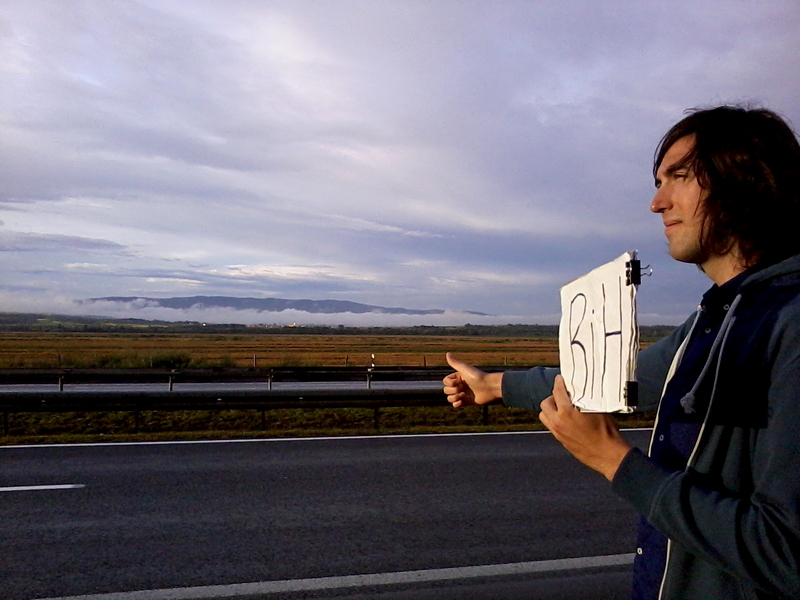
At Banja Luka we saw our first minaret – a slim circular tower capped off by a conical roof and ringed by a balcony near the top giving it a slightly mushroom-like look – an elegant Turkish design quite different from the one you see in Morocco. The sound of the call to prayer (azam) was much milder than in Morocco, possibly because it did not have to compete with several neighboring mosques.
We did no sightseeing and yet once again it was nearly 5pm when we stuck a thumb out. This was a mistake because it’s harder to find rides and the possibility of getting stranded at night is much higher. The reason for the late start, other than waking up late, was a dinner in a traditional restaurant we stumbled upon. It was on a river bank. The river swelled with rain water making it look like we were in motion. The food was fantastic – I had čevapi, a relative of kofta kebab and a simple shepherd’s salad with vegetables so flavorful that I cannot find a non-embarrassing metaphor for it.
From Banja Luka a truck driver got us about half way to Sarajevo. It was already dark and we had no further luck with rides. It started raining and we slept in an entry way to a car part store. It’s a good thing I bought a sleeping bag in Ljubljana. A credit card being the only thing separating me from a homeless person. What is more embarrassing to an American than being poor? The next morning we got a ride right away but it was just to some village and for several hours no one would stop. I decided to change our luck and walk five kilometers to a highway intersection. Matt had a map application on his phone and it saved our butt many times especially when we got dropped off in an unexpected spot by our ride.
As we stood there we saw a figure approaching. We thought it was another hitcher, possible competition. But he turned out to be a hiker, a farmer from Ireland. He sometimes took the bus to get out of populated areas and camped under a tarp. He just wanted to see nature.
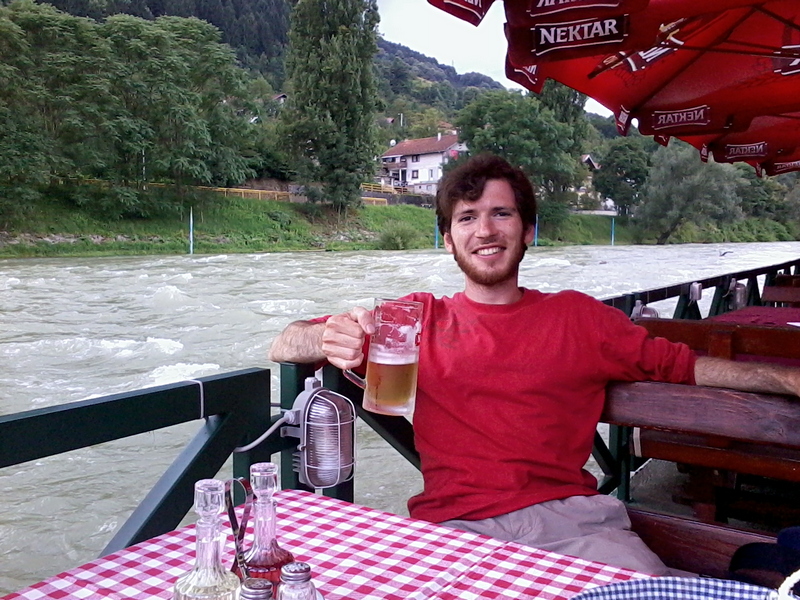
Sarajevo
Sarajevo is shaped like a comet. In the east is the dense core of the old city and shooting west from it is the long, narrow tail of the new city with war damaged buildings making up the frayed ending. A river runs through the valley in which the city sits. It used to split it into roughly Christian and Muslim parts but there aren’t many Serbs left in Sarajevo anymore. Although there are some houses climbing up from the valley, most of the big buildings hug the river and the city is only a few blocks wide making it seem like a city built on a bridge. There’s pretty much just one tram line running through the whole city.
Right away there was something about the city that made me fall in love. Maybe it was the thrill of arriving somewhere after such a trial. But that wouldn’t be giving Sarajevo enough credit. The city felt very alive. We went out later to the old part of the city, called Baščaršija (from the Turkish for “head market”). It was Saturday night and it was full of people out for the night dressed in their best. There were tons of bars and restaurants with crowds spilling out. Many had outdoor seating running down the middle of the street. Some had dj’s playing outside. It wasn’t just one block, we walked for at least ten minutes and didn’t see the end. We heard many languages. Sarajevo is very popular with Turks.
Baščaršija preserves many Turkish elements. There are many courtyard cafes, craft shops, several mosques. The streets are cobbled and it is closed to car traffic. Just above it lie several cemeteries with graves dating from the siege of Sarajevo. Seeing so many people taken in the prime of their life buried one next to the other in neat rows of simple white monuments really brought the reality of war to me. The city also bears its scars, especially near its edges where many buildings have bullet holes or other damage. I cannot speak of its people’s souls.
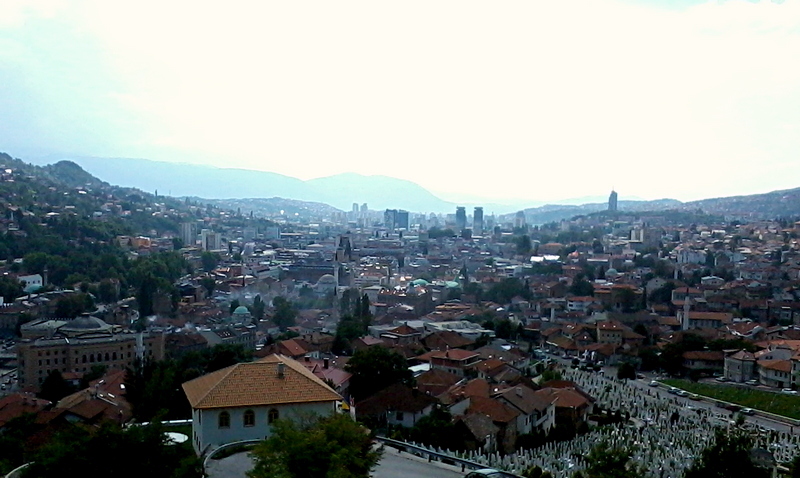
Just a short ride from the city you can find quiet. We went to a party in the hills. Rakiya, the traditional local alcohol, was the drink of choice. Slivovica (plum) is the most well known variety but my favorite is Medovica (honey) especially when flavored with pine. It is sipped, not drunk like a shot. In the morning a group from the party walked over to a waterfall and the brave ones took a dip in its frigid waters.
On another night we visited Kino Bosna – the alternative to the glitz of Baščaršija. Smoke hung thick over the entire cavernous hall of this former movie theater. Old movie posters in Bosnian advertising everything from Hollywood to Indian and Egyptian films hung on the walls. A band of four old men playing traditional songs moved between the tables but could barely be heard over the din of conversation even a few tables away.
Sarajevo has no pretension to it. It’s not cool and it’s not trying to be, unlike Ljubljana or Belgrade. The food is especially excellent. It’s not just the čevapi which claims its home here. There were many varieties of burek-like pastries. Even the crepes, palacinke, were better than ones I’ve tried elsewhere.
After Sarajevo we parted ways. Matt would be going to Montenegro and later to Bulgaria, while I was heading to Serbia. We made plans to meet up in Krakow in September. Warp, a leading electronic music label from the UK would be having its twenty-fifth anniversary concert there.
